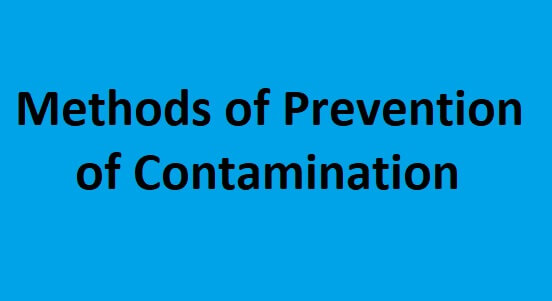The steps by which microbial contamination of products can be prevented in aseptic areas are discussed below:
Personnel : They can take the following measures:
Access to production areas by the unauthorised personnel should be restricted, and only trained ones should be allowed to enter.
Adequate personnel hygiene should be maintained.
The personnel should be given proper and regular training with respect to hygiene as well to ensure that their activities do not hamper the product quality.
Personnel entering the manufacturing area should wear protective clothing (over-garments, hair cover, beard or moustache cover, and overshoes).
Personnel should avoid touching with naked hands the exposed products or any part of equipment in contact with the product.
Facility Design : This includes the following measures:
In aseptic rooms, the differential air pressures should be higher than the adjacent controlled areas.
Air filtration and air change rates should be set to attain the defined clean room class.
Unidirectional (laminar flow) air flow should be maintained over critical areas at sufficient velocity to sweep particles away from filling/closing area.
Ambient temperature and humidity should not be very high.
The ventilated cabinets, RABS (Restricted Access Barrier System), isolators systems, etc. should be used depending on the facility/product risk assessment results in order to achieve an absolute or partial barrier to contain microorganisms at their point of use.
The areas of unequal risk are separated by UV air locks and door barriers.
All open-container processing should be performed within the isolator/RABS.
The air pressure of the changing room should be negative with respect to the manufacturing area corridor, but positive with respect to the external adjacent areas.
The ventilation dampers, specially designed filters, and other services should be positioned such that they can be accessed from outside the manufacturing areas (service voids or service corridors) for maintenance purposes.
An impermeable barrier should be used in appropriate areas to prevent cross-contamination between two zones, such as closed systems, pumped, or vacuum transfer of materials.
HVAC air distribution components should be used for preventing the spreading of contaminants generated within the room.
All rooms and surfaces should be maintained and monitored for viable and nonviable particulates and this facility should be re-certified on a semi-annual basis.
Facility and equipment design cannot eliminate microbial contamination completely, but good risk assessment and consequent hygienic design can reduce these risks several times.
For example,
- Flow of man and material should be uniform,
- Equipment having smooth surfaces of appropriate material can facilitate effective cleaning, and
- Closed Material Transfer Systems.
Access to Areas : This includes the following measures:
Access to production, packaging, and QC areas by un-authorised personnel should be restricted.
Personnel should gain access to these areas only via changing rooms.
Materials should be accessed via specific routes (generally air locks).
Building Requirements : This includes the following measures:
Smooth, crack-free, and easily cleanable floors, walls, and ceilings should be used as they facilitate easy and effective cleaning.
Windows or viewing panels should be closed (non-opening), fixed with wall panels, and sealed to prevent accumulation of dust and microbial contaminants.
The designing of pipe work, ventilation, and light points should be such that creation of recesses which are not easily cleanable is avoided.
Sinks of stainless steel should be present within the production areas.
Cleaning and Disinfection : This includes the following measures:
Time-to-time cleanliness and disinfection of the areas should be done.
Adequate hygiene should be maintained in every aspect of the drug product manufacturing.
Cleaning agents of proper grades should be used for minimising health risks.
Contact time, application, temperature, mechanical action, and the chemistry of cleaning agents should be considered during the cleaning process.
The cleaning agents should not be directly applied on the product.
The cleaning practices should be validated to prove that the process effectively controls microbial contamination.
Utilities : This includes the following measures:
Water of pharmaceutical grade, microbiologically controlled and monitored should be used in the manufacturing of products.
Clean and additive-free steam should be used for cleaning and sanitisation of production tools and equipment, and to supply for autoclaves and humidification.
| Read More Topics |
| Different sources of contamination in an aseptic area |
| Types of laminar airflow hood |
| Embryonated hen’s egg introduction |
| Isolation method for pure culture of bacteria |






